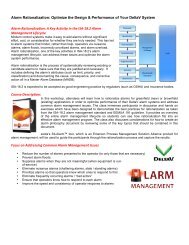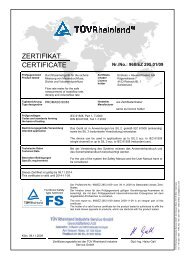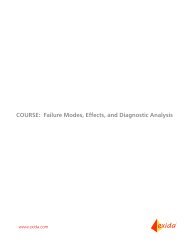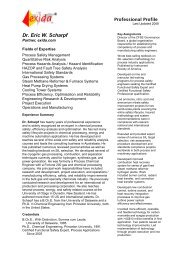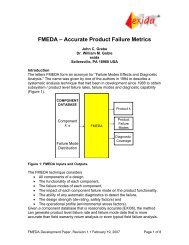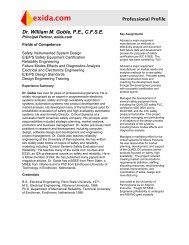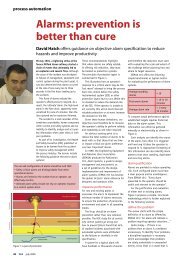IEC 61508 Functional Safety Assessment Emerson Process ... - Exida
IEC 61508 Functional Safety Assessment Emerson Process ... - Exida
IEC 61508 Functional Safety Assessment Emerson Process ... - Exida
You also want an ePaper? Increase the reach of your titles
YUMPU automatically turns print PDFs into web optimized ePapers that Google loves.
5.27 Hardware <strong>Assessment</strong><br />
To evaluate the hardware design of the 3144P Temperature Tansmitter, a Failure Modes, Effects,<br />
and Diagnostic Analysis was performed by exida. This is documented in [R2].<br />
A Failure Modes and Effects Analysis (FMEA) is a systematic way to identify and evaluate the<br />
effects of different component failure modes, to determine what could eliminate or reduce the<br />
chance of failure, and to document the system in consideration. An FMEDA (Failure Mode Effect<br />
and Diagnostic Analysis) is an FMEA extension. It combines standard FMEA techniques with<br />
extension to identify online diagnostics techniques and the failure modes relevant to safety<br />
instrumented system design.<br />
From the FMEDA failure rates are derived for each important failure category. Table 1 lists these<br />
failure rates as reported in the FMEDA report for the case where a single 4-wire RTD is used. The<br />
failure rates are valid for the useful life of the devices. Based on <strong>Emerson</strong> endurance test data and<br />
general field failure data a useful life period of approximately 50 years is expected for the 3144P.<br />
This is listed in the FMEDA reports. Note that if the device is using a thermocouple rather than an<br />
RTD or if more than one RTD’s are used, the failure rates will differ and the FMEDA should be<br />
consulted to determine the correct failure rates.<br />
Table 1 Failure rates according to <strong>IEC</strong> <strong>61508</strong> – 3144P Temperature Transmitter with single RTD<br />
Failure Categories SD SU DD DU SFF<br />
Low trip 265 FIT 112 FIT 20 FIT 40 FIT 90.8%<br />
High trip 20 FIT 112 FIT 265 FIT 40 FIT 90.8%<br />
An average Probability of Failure on Demand (PFD AVG ) calculation is performed for a single (1oo1)<br />
3144P Temperature Transmitter with single 4-wire RTD. The failure rate data used in this<br />
calculation is displayed in section 5.2.1 or [R2]Error! Reference source not found.. It is assumed<br />
that the transmitter output is send low upon detection of failure and the safety function has a low<br />
trip point.<br />
The resulting PFD AVG values for a variety of proof test intervals are displayed in Figure 1. As shown<br />
in the figure the PFD AVG value for a single 3144P Temperature Transmitter with single 4-wire RTD,<br />
with a proof test interval of 1 year equals 2.38E-04.<br />
© exida Certification rosemount 11-02-57 r002 iec <strong>61508</strong> assessment.docx, 5/14/2012<br />
Michael Medoff Page 18 of 21



